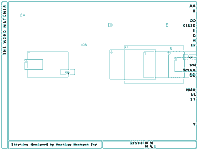


| URL: | http://netzspannung.org/database/96351/de |
| Last update: | 28.06.2003 |
| Date of print: |
 |
The Word Watcher |
Technik
Technische Beschreibung
The Word Watcher is developed in Macromedia Director MX. The application is coded in Lingo.
The Word Watcher can be used online at www.martinehermsen.net/thewordwatcher.html
Hardware / Software
Macromedia Director MX
Kontext
Hochschule / Fachbereich
Ravensbourne College of Design and Communication
Interactive Digital Media
URL der Hochschule
» http://www.rave.ac.uk
Betreuer des Projekts
Prof. Karel Dudesek
Kommentar des Betreuers
The Word Watcher is an application that gives its users a new view on languages. It visualises the statistical structure of English, French, Dutch and German in an animation, and from these statistics it can conclude in which language a text is written. The user is challenged to create a text that The Word Watcher cannot recognise. By doing that, the user develops an understanding of the similarities and differences in spelling between the used languages. The main focus point in developing the concept was to make the user experience languages in an active and creative way.
People who use the programme do start to experiment with sentences in different languages. Many speakers of other languages have asked if they could be added.
Personally I find it very interesting that it compares languages, it is not often that one thinks of how a language is related to other languages. Another thing what is important, how well it works. It is right over 95% of the time.
Seminar / Kurzbeschreibung
MA Interactive Digital Media at Ravensbourne College, London, is a relatively new course, since 1 year led by Professor Karel Dudesek of Vienna, who brings experience on a wide range of activities from media arts to interactive television to virtual reality. The intention is to offer a much broader horizon for students than that of typical "multimedia courses" The students & staff of MA IDM are involved with creating projects in interactivity, visual and audio mediums, online and networked systems and generally exploring new approaches to technology. This has been realized through the ongoing development of an MA Experimental Resource -<XR>- a studio with a philosophy to develop "space based media", both actual and virtual. What we are developing is a resource for spatial sound installation, a virtual set area, use of tracking and interactive sensing equipment, all linked to computers and software such as Max, MSP, Nato. We are inviting students to use sensors and electronics to make real-time interaction, and to think about presenting their work in a different way. In the first year it has been the introduction of Max software into the curriculum that has kick-started this progression to a new kind of work, and the creation of some exciting projects.
Zuordnung Forschungsbereich
In the current second year, students have realised projects with spatial interaction and sound, using techniques such as video tracking and surround sound positioning. The current interest both from staff and students are works that reflect upon the experience of time based, or real-time art works, and that uses processes available in the software such as Max/MSP/Jitter to make prototypes and presentations of these ideas. Time is certainly a key part of media art installations. Viewers are familiar with works that are immersive, whether by use of VR equipment or large scale projection, and are seemingly looking for works that allow themselves to be immersed in the technology. What is interested in using software that can work in real-time and interactively, is that the "time" element of the work can be played with and thus we have ideas such as the memory recorder. Previous projects and works in progress are showcased on the website at: http://www.ma.rave.ac.uk/xr/
|
|
| » http://www.martinehe…t/thewordwatcher.html |
|
|